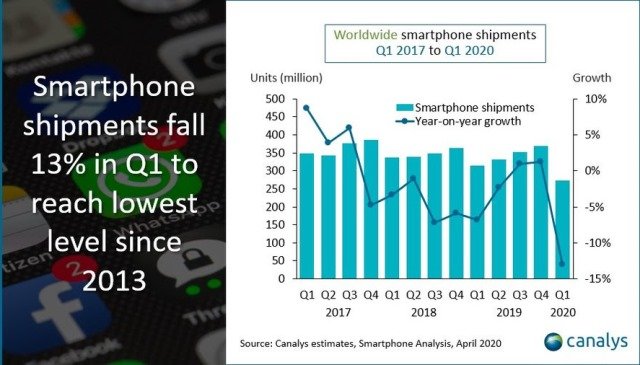Apple has reported sales of $58.3 billion in its fiscal second quarter ended in March, as compared with $58 billion year-ago.
 Apple’s iPhone sales were $29 billion in the March quarter as compared with $30.9 billion the year before.
Apple’s iPhone sales were $29 billion in the March quarter as compared with $30.9 billion the year before.
The report from Strategy Analytics said Apple iPhone shipments fell 9 percent from 43.1 million units worldwide in Q1 2019 to 39.2 million in Q1 2020. Apple’s global smartphone market share has risen from 13 percent to 14 percent in the past year.
“Apple’s new iPhone SE model with lower pricing and larger presence in emerging markets like India will give volumes a further bump in the coming months,” Woody Oh, director at Strategy Analytics, said.
The latest IDC report said Apple shipped 36.7 million (–0.4 percent) iPhones grabbing third place with 13.3 percent share in the global smartphone market. The lowest annual decline among the top 3 smartphone vendors is primarily due to the continued success of its iPhone 11 series.
“The launch of the SE 2020 device targeting the lower-priced segment could work well for the vendor if consumers shift their buying preferences towards more budget-friendly devices in the uncertain economic climate of 2020,” said Nabila Popal, research director with IDC’s Worldwide Mobile Device Trackers.
 The latest Canalys report said Apple was one of the least affected vendors, owing to strong sales of the iPhone 11 in the early stages of the quarter.
The latest Canalys report said Apple was one of the least affected vendors, owing to strong sales of the iPhone 11 in the early stages of the quarter.
“Its recent iPhone SE launch is vital, as Apple needs to prop up iPhone shipments as its flagship customers await 5G devices,” Canalys Analyst Shengtao Jin said.
Apple total sales $58.3 billion
iPhone $28.962 bn
Mac $5.351 bn
iPad $4.368 bn
Wearables $6.284 bn
Services $13.348 bn
Apple CEO Tim Cook said it was impossible to forecast overall results for the current quarter because of uncertainty created by the COVID-19 virus.
Sales of subscription services such as streaming television content rose with billions of people locked in their homes, which pushed the overall number of subscribers to paid apps and services on Apple’s devices to 515 million.
China, where the virus was first detected, is both a major market for Apple, supplying about a sixth of its overall sales, and is also home to most of Apple’s contract factories.
Apple’s China sales fell by less than a $1 billion from a year ago to $9.46 billion, showing the sign of how the company will fare as other markets emerge from lockdowns.
Apple slowly reopened Chinese stores, with all running again by mid-March. “As compared to February, we saw a nice improvement in March and a further improvement in April. China is headed in the right direction,” Tim Cook told Reuters in an interview.
Apple stores outside mainland China, Hong Kong, Taiwan and South Korea remained shuttered. Bloomberg Television reported that Apple plans to reopen retail stores in Austria and Australia in one to two weeks and a small number of stores in the United States in the first half of May.
Lockdowns forced Apple to release its newest iPhone SE 2 mostly via online sales. Tim Cook said that he was pleased with early sales of the new device, along with new Macs and iPads released during the fiscal second quarter.
Tim Cook declined to comment on whether Apple faces supply chain disruptions for devices that will be released later this year. He said Apple’s supply chain was “back up and running at full-throttle at the end of March.”
Sales for Apple’s services segment, which includes iCloud storage as well as its streaming services for music and television shows, were $13.4 billion.
Cook said Apple had 515 million subscribers to apps and services on Apple’s platform, up by 125 million from one year earlier. Tim Cook said during a conference call with analysts that Apple News reached 125 million monthly active users, up from 100 million in January.
Apple’s wearables and accessories segment, which includes Apple’s AirPods and Apple Watch, were $6.3 billion.





